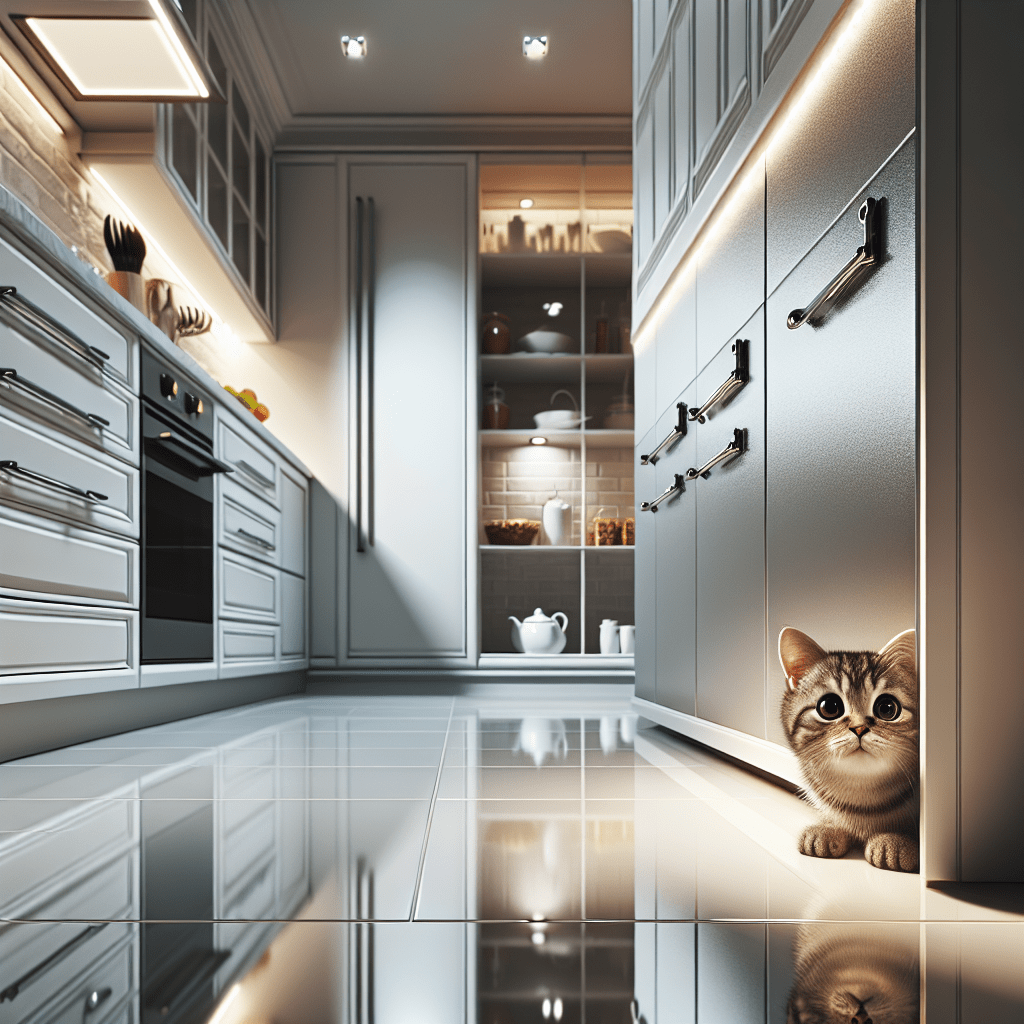Cats are notoriously curious creatures. If you’re a cat owner, you’ve likely encountered the frustrating scenario of finding your feline friend rummaging through your cupboards. While their antics can be amusing, they can also be hazardous for your cat and your household. Here’s how to keep cats out of cupboards and maintain a safe, harmonious home environment.
Table of Contents
Why Cats Jump on Countertops and Tables
Natural Instincts and Behaviors
Cats are natural explorers. Their desire to reach high places is deeply ingrained in their wild ancestry. They love to survey their territory from an elevated vantage point. This instinct drives them to jump on countertops and tables, where they can have a better view of their surroundings. Additionally, cats are inquisitive and investigate every nook and cranny.
Environmental Factors
Leaving food out on countertops can be a significant attraction for cats. The smell of delicious morsels can be irresistible and will encourage them to jump up and investigate. Interesting objects like shiny utensils or decorative items can also catch their eye and stimulate their curiosity. Understanding these motivations is the first step in mitigating this behaviour.
Preventive Measures
Remove Temptations
One of the simplest ways to discourage your cat from jumping on countertops is to remove anything that might tempt them. Store all food items in cat-proof containers, such as Tupperware or bread bins. Keeping your countertops clean and free of food crumbs will minimize your cat’s interest in exploring these areas.
Secure Trash and Cabinets
Cats often knock over trash cans or get into cabinets out of curiosity. To prevent your cat from sneaking inside and getting into trouble, use sturdy lids on garbage cans and store them in closed cupboards. Installing child-proof latches on cabinets can also prevent your cat from getting into trouble.
Providing Alternatives
Create Elevated Spaces
Cats need high places to feel secure and entertained. Invest in a good-quality cat tree or clear off a top shelf in a bookcase specifically for your cat. Windowsills can also be converted into perching spots, offering your cat a place to watch the world go by.
Encourage Use of Alternatives
Use catnip or treats to attract your cat to make these elevated spaces more appealing. Cozying up with towels or blankets will also increase the likelihood that your cat will choose them over your countertops.
Making Countertops Unattractive
Pet-Safe Booby Traps
Consider using pet-safe deterrents if your cat consistently jumps on countertops despite your best efforts. Products like Sticky Paws double-sided tape or X-Mat Original Pet Mat create textures that cats dislike. Other options include coir welcome mats, Premier Spray Sentry, or Ssscat, which can help deter your cat from these areas without causing harm.
Avoid Physical Punishment
It’s important to avoid physical punishment, such as yelling, hitting, or spraying water at your cat. These methods could be more effective and harm your relationship with your pet. Instead, focus on positive reinforcement techniques to encourage better behaviour.

Training and Behavior Modification
Positive Reinforcement
Rewarding your cat for using designated areas instead of countertops can help reinforce good behaviour. Consistently praise and treat your cat when they choose their cat tree or another appropriate space. Over time, this positive reinforcement will help them learn where they are allowed to go.
Consistency and Patience
Behaviour modification takes time and patience. Be consistent with your training efforts, and understand that your cat may take a while to grasp what you expect of them entirely. Stay patient and persistent, and you’ll eventually see results.
Additional Tips and Tricks
Close Doors
If possible, keep doors closed to restrict your cat’s access to specific areas, especially when you’re not around to supervise. This simple step can help prevent unwanted behaviour and keep your home tidy.
Interactive Play
Engage your cat with interactive toys to reduce boredom and channel their energy into appropriate activities. Regular play sessions can help satisfy their hunting instincts and make them less likely to seek entertainment by exploring off-limits areas.
Environmental Enrichment
Providing your cat with plenty of stimulating activities can reduce their interest in exploring countertops. Scratching posts, puzzle feeders, and other enrichment tools can keep them engaged and content.
Conclusion
Keeping your cat from causing chaos on countertops and cupboards is about understanding what drives their behaviour, eliminating temptations, offering alternatives, and giving them positive vibes. These tricks help create a cozy and peaceful home for you and your feline buddy.
Please share your stories and any extra tips with us! Drop them in the comments below! And hey, for more insights on managing those counter-jumping acrobatics, grab our handy PDF guide or chat with our pet behaviour pros for tailored advice.
Following these easy steps will strengthen your bond with your cat and keep your home pet-friendly. Enjoy the training sessions!
Frequently Asked Questions (FAQ)
How can I stop my cat from jumping on the counters when I’m not home?
Training your cat to stay off countertops involves consistent and persistent efforts even when you’re not around. Consider using deterrents like pet-safe booby traps or automatic sprayers in those areas. Also, ensure your cat has access to alternative elevated spaces that are more attractive, such as cat trees or window perches.
Are there any safe deterrents I can use to keep my cat off countertops?
Absolutely! Products like Sticky Paws double-sided tape or X-Mat Original Pet Mat work great to create textures that cats find unpleasant. You can also use motion-activated deterrents like Premier Spray Sentry or Ssscat to startle them without causing harm.
Is yelling or using a spray bottle an effective way to stop my cat from jumping on the counters?
No, these methods are not recommended. Physical punishment, such as yelling or spraying water, can damage the trust and bond between you and your cat. Positive reinforcement and consistency are more effective and humane approaches to modifying behaviour.
What if my cat still won’t stop jumping on countertops?
Suppose your cat continues to jump on countertops despite your best efforts. It may be time to consult a pet behaviour specialist in that case. They can provide tailored advice and strategies to address the issue more effectively.
How can I make my cat’s designated spots more appealing?
To make these areas inviting, attract your cat with catnip, treats, or toys. Cozy elements like towels or blankets near windows can make these spots more attractive.
Will keeping my cat off the counters affect their happiness?
Not at all! Providing plenty of alternative elevated spaces, interactive play, and environmental enrichment ensures your cat remains happy and stimulated even if countertops are off-limits.
Can I train an older cat to stay off countertops, or is it too late?
It’s always possible to train your cat. While modifying an older cat’s behaviour may take more time and patience, consistent and positive reinforcement can help them learn new habits more effectively than younger cats.
By thoughtfully addressing these common concerns, you can maintain a more harmonious home environment while keeping your adventurous feline friend happy and engaged.
Sarah Smith is a passionate dog and cat enthusiast, blogger, and pet care expert. With years of experience researching and writing about various dog breeds cat breeds, she brings a wealth of knowledge and insight to her blog, PetPession.com. Sarah loves exploring the unique traits, histories, and care needs of different breeds, helping pet owners make informed decisions. Her mission is to create helpful, friendly, and well-researched content that both educates and celebrates the joy of pet ownership. When she’s not writing, Sarah enjoys outdoor adventures with her own furry friends.


1 thought on “How to Keep Your Cat Off Countertops: Proven Tips and Tricks”